The Interaction between Strigolactone and Auxin Results in the Negative Effect of Shading on Soybean Branching Development
Abstract
:1. Introduction
2. Materials and Methods
2.1. Experimental Site and Planting Material
2.2. Treatments and Experimental Details
2.3. Morphological Measurements
2.4. Measurement of Hormone Levels
2.5. Real-Time Quantitative PCR
2.6. Statistical Analysis
3. Results
3.1. Shading Treatment Slowed the Branching Development of Soybean, but There Were Significant Differences among Varieties
3.2. The Gene Expression Levels of GmPIL, GmPhyA, and GmPhyB Varied between Different Genotypes under Shading Treatment
3.3. Shading Treatment Changed the Content and Related Gene Expression of SL in Soybean Axillary Buds
3.4. IAA, SL, and Their Inhibitors Had Different Effects on the Branching Characteristics of Soybean under Different Light Conditions
3.5. The Increase in IAA Content Promoted SL Biosynthesis
3.6. The Increase in SL Content Promoted IAA Biosynthesis
4. Discussion
5. Conclusions
Supplementary Materials
Author Contributions
Funding
Data Availability Statement
Conflicts of Interest
References
- Han, Y.M. The microworld behind high yield of soybean. Grain Sci. Technol. Econ. 2020, 45, 14–15. [Google Scholar]
- Bai, Y.; Zhai, Y.; Ji, C.; Zhang, T.; Chen, W.; Shen, X.; Hong, J. Environmental sustainability challenges of China’s edible vegetable oil industry: From farm to factory. Resour. Conserv. Recycl. 2021, 170, 105606. [Google Scholar] [CrossRef]
- Yang, H.; Zhang, W.; Long, L.I. Intercropping: Feed More People and Build More Sustainable Agroecosystems. Front. Agric. Sci. Eng. 2021, 8, 14. [Google Scholar]
- Stomph, T.J.; Dordas, C.; Baranger, A.; Rijk, J.D.; Dong, B.; Evers, J.B.; Gu, C.; Li, L.; Simón, J.C.; Jensen, E.S.; et al. Designing intercrops for high yield, yield stability and efficient use of resources: Are there principles? Adv. Agron. 2019, 160, 1–50. [Google Scholar]
- Wu, Y.S.; Gong, W.Z.; Liao, D.P.; Wu, X.L.; Yang, F.; Liu, W.G.; Yong, T.W.; Yang, W.Y. Effects of Shade and Light Recovery on Soybean Cultivars (Lines) and Its Relationship with Yield in Relay Strip Intercropping System. Acta Agron. Sin. 2015, 41, 1740–1747. [Google Scholar] [CrossRef]
- Awal, M.A.; Koshi, H.; Ikeda, T. Radiation interception and use by maize/peanut intercrop canopy. Agric. For. Meteorol. 2006, 139, 74–83. [Google Scholar] [CrossRef]
- Li, C.; Hoffland, E.; Kuijper, T.W.M.; Yu, Y.; Li, H.; Zhang, C.; Zhang, F.; van der Werf, W. Yield gain, complementary and competitive dominance in intercropping in China: A meta-analysis of drivers of yield gain using additive partitioning. Eur. J. Agron. 2020, 113, 125987. [Google Scholar] [CrossRef]
- Liu, W.G.; Hussain, S.; Liu, T.; Zou, J.L.; Ren, M.L.; Zhou, T.; Liu, J.; Yang, F.; Yang, W.Y. Shade stress decreases stem strength of soybean through restraining lignin biosynthesis. J. Integr. Agric. 2019, 18, 43–53. [Google Scholar] [CrossRef]
- Raza, M.A.; Feng, L.Y.; Iqbal, N.; Ahmed, M.; Chen, Y.K.; Khalid, M.H.B.; Mohi Ud Din, A.; Khan, A.; Ijaz, W.; Hussain, A.; et al. Growth and development of soybean under changing light environments in relay intercropping system. PeerJ 2019, 7, e7262. [Google Scholar] [CrossRef]
- Cheng, Y.J.; Chen, J.X.; Wang, Z.L.; Fan, Y.F.; Chen, S.Y.; Li, Z.L.; Liu, Q.L.; Li, Z.C.; Yang, F.; Yang, W.Y. Effects of light intensity and light quality on morphology and photosynthetic characteristics of soybean seedlings. Chin. J. Agric. Sci. 2018, 51, 2655–2663. [Google Scholar]
- Pierik, R.; Ballaré, C.L. Control of Plant Growth and Defense by Photoreceptors: From Mechanisms to Opportunities in Agriculture. Mol. Plant 2021, 14, 61–76. [Google Scholar] [CrossRef] [PubMed]
- Xu, H.; Chen, P.; Tao, Y. Understanding the Shade Tolerance Responses through Hints from Phytochrome A-Mediated Negative Feedback Regulation in Shade Avoiding Plants. Front. Plant Sci. 2021, 12, 813092. [Google Scholar] [CrossRef] [PubMed]
- Park, E.; Park, J.; Kim, J.; Nagatani, A.; Lagarias, J.C.; Choi, G. Phytochrome B inhibits binding of phytochrome-interacting factors to their target promoters. Plant J. Cell Mol. Biol. 2012, 72, 537–546. [Google Scholar] [CrossRef]
- Reed, J.W. Mutations in the gene for the red far-red light receptor phytochrome-B alter cell elongation and physiological-responses throughout Arabidopsis development. Plant Cell 1993, 5, 147–157. [Google Scholar] [PubMed]
- Yu, X.; Dong, J.; Deng, Z.; Jiang, Y.; Wu, C.; Qin, X.; Terzaghi, W.; Chen, H.; Dai, M.; Deng, X.W. Arabidopsis PP6 phosphatases dephosphorylate PIF proteins to repress photomorphogenesis. Proc. Natl. Acad. Sci. USA 2019, 116, 20218–20225. [Google Scholar] [CrossRef]
- Fankhauser, C.; Batschauer, A. Shadow on the Plant: A Strategy to Exit. Cell 2016, 164, 15. [Google Scholar] [CrossRef]
- Shafiq, I.; Hussain, S.; Raza, M.A.; Iqbal, N.; Asghar, M.A.; Raza, A.; Fan, Y.; Mumtaz, M.; Shoaib, M.H.; Ansar, M.; et al. Crop photosynthetic response to light quality and light intensity. J. Integr. Agric. 2021, 20, 4–23. [Google Scholar] [CrossRef]
- Feng, L.; Raza, M.A.; Li, Z.; Chen, Y.; Khalid, M.H.B.; Du, J.; Liu, W.; Wu, X.; Song, C.; Yu, L.; et al. The Influence of Light Intensity and Leaf Movement on Photosynthesis Characteristics and Carbon Balance of Soybean. Front. Plant Sci. 2019, 9, 1952. [Google Scholar] [CrossRef]
- Leeflang, L. Are stoloniferous plants able to avoid neighbours in response to low R: FR ratios in reflected light? Plant Ecol. 1999, 141, 59–65. [Google Scholar] [CrossRef]
- Wang, X.; Gao, X.; Liu, Y.; Fan, S.; Ma, Q. Progress of Research on the Regulatory Pathway of the Plant Shade-Avoidance Syndrome. Front. Plant Sci. 2020, 11, 439. [Google Scholar] [CrossRef]
- Liu, Y.; Jafari, F.; Wang, H. Integration of light and hormone signaling pathways in the regulation of plant shade avoidance syndrome. aBIOTECH 2021, 2, 131–145. [Google Scholar] [CrossRef] [PubMed]
- Xie, Y.; Liu, Y.; Ma, M.; Zhou, Q.; Zhao, Y.; Zhao, B.; Wang, B.; Wei, H.; Wang, H. Arabidopsis FHY3 and FAR1 integrate light and strigolactone signaling to regulate branching. Nat. Commun. 2020, 11, 1955. [Google Scholar] [CrossRef] [PubMed]
- Pedersen, P.; Lauer, J.G. Soybean growth and development in various management systems and planting dates. Crop. Sci. 2004, 44, 508–515. [Google Scholar] [CrossRef]
- González-Grandío, E.; Poza-Carrión, C.; Sorzano, C.O.; Cubas, P. BRANCHED1 promotes axillary bud dormancy in response to shade in Arabidopsis. Plant Cell 2013, 5, 834–850. [Google Scholar] [CrossRef]
- Kebrom, T.H.; Brutnell, T.P.; Finlayson, S.A. Suppression of sorghum axillary bud outgrowth by shade, PhyB and defoliation signalling pathways. Plant Cell Environ. 2010, 33, 48–58. [Google Scholar] [CrossRef]
- Sun, Z.; Su, C.; Yun, J.; Jiang, Q.; Wang, L.; Wang, Y.; Cao, D.; Zhao, F.; Zhao, Q.; Zhang, M.; et al. Genetic improvement of the shoot architecture and yield in soya bean plants via the manipulation of GmmiR156b. Plant Biotechnol. J. 2019, 17, 50–62. [Google Scholar] [CrossRef]
- Haq, B.U.; Ahmad, M.Z.; Rehman, N.U.; Wang, J.; Jian, Z. Functional characterization of soybean strigolactone biosynthesis and signaling genes in Arabidopsis MAX mutants and GmMAX3 in soybean nodulation. BMC Plant Biol. 2017, 17, 259. [Google Scholar] [CrossRef]
- Ge, S.; He, L.; Jin, L.; Xia, X.; Li, L.; Ahammed, G.J.; Qi, Z.; Yu, J.; Zhou, Y. Light-dependent activation of HY5 promotes mycorrhizal symbiosis in tomato by systemically regulating strigolactone biosynthesis. N. Phytol. 2022, 233, 1900–1914. [Google Scholar] [CrossRef]
- Ruyter-Spira, C.; Al-Babili, S.; van der Krol, S.; Bouwmeester, H. The biology of strigolactones. Trends Plant Sci. 2013, 18, 72–83. [Google Scholar] [CrossRef]
- Chen, C.Y.; Zou, J.H.; Zhang, S.Y.; Zhu, L.H. Strigolactone inhibits plant branching and mediates interactions between plants and abietic fungi and parasitic plants. Sci. China Ser. C Life Sci. 2009, 39, 525–533. [Google Scholar]
- Harrison, E.H. Carotenoids, β-Apocarotenoids, and Retinoids: The Long and the Short of It. Nutrients 2022, 14, 1411. [Google Scholar] [CrossRef] [PubMed]
- Umehara, M.; Hanada, A.; Yoshida, S.; Akiyama, K.; Arite, T.; Takeda-Kamiya, N.; Magome, H.; Kamiya, Y.; Shirasu, K.; Yoneyama, K.; et al. Inhibition of shoot branching by new terpenoid plant hormones. Nature 2008, 455, 195–200. [Google Scholar] [CrossRef]
- López-Ráez, J.A.; Charnikhova, T.; Gómez-Roldán, V.; Matusova, R.; Kohlen, W.; De Vos, R.; Verstappen, F.; Puech-Pages, V.; Bécard, G.; Mulder, P.; et al. Tomato strigolactones are derived from carotenoids and their biosynthesis is promoted by phosphate starvation. New Phytol. 2008, 178, 863–874. [Google Scholar] [CrossRef] [PubMed]
- Booker, J.; Auldridge, M.; Wills, S.; McCarty, D.; Klee, H.; Leyser, O. MAX3/CCD7 is a carotenoid cleavage dioxygenase required for the synthesis of a novel plant signaling molecule. Curr. Biol. 2004, 14, 1232–1238. [Google Scholar] [CrossRef] [PubMed]
- Johnson, X.; Brcich, T.; Dun, E.A.; Goussot, M.; Haurogné, K.; Beveridge, C.A.; Rameau, C. Branching genes are conserved across species. Genes controlling a novel signal in pea are coregulated by other long-distance signals. Plant Physiol. 2006, 142, 1014–1026. [Google Scholar] [CrossRef]
- Arite, T.; Iwata, H.; Ohshima, K.; Maekawa, M.; Nakajima, M.; Kojima, M.; Sakakibara, H.; Kyozuka, J. DWARF10, an RMS1/MAX4/DAD1 ortholog, controls lateral bud outgrowth in rice. Plant J. Cell Mol. Biol. 2007, 51, 1019–1029. [Google Scholar] [CrossRef]
- Snowden, K.C.; Simkin, A.J.; Janssen, B.J.; Templeton, K.R.; Loucas, H.M.; Simons, J.L.; Karunairetnam, S.; Gleave, A.P.; Clark, D.G.; Klee, H.J. The Decreased apical dominance1/Petunia hybrida Carotenoid Cleavage Dioxygenase8 gene affects branch production and plays a role in leaf senescence, root growth, and flower development. Plant Cell 2005, 17, 746–759. [Google Scholar] [CrossRef]
- Sorefan, K.; Booker, J.; Haurogné, K.; Goussot, M.; Bainbridge, K.; Foo, E.; Chatfield, S.; Ward, S.; Beveridge, C.; Rameau, C.; et al. MAX4 and RMS1 are orthologous dioxygenase-like genes that regulate shoot branching in Arabidopsis and pea. Genes Dev. 2003, 17, 1469–1474. [Google Scholar] [CrossRef]
- Booker, J.; Sieberer, T.; Wright, W.; Williamson, L.; Willett, B.; Stirnberg, P.; Turnbull, C.; Srinivasan, M.; Goddard, P.; Leyser, O. MAX1 encodes a cytochrome P450 family member that acts downstream of MAX3/4 to produce a carotenoid-derived branch-inhibiting hormone. Dev. Cell 2003, 8, 443–449. [Google Scholar] [CrossRef]
- Matusova, R.; Rani, K.; Verstappen, F.W.; Franssen, M.C.; Beale, M.H.; Bouwmeester, H.J. The strigolactone germination stimulants of the plant-parasitic Striga and Orobanche spp. are derived from the carotenoid pathway. Plant Physiol. 2005, 139, 920–934. [Google Scholar] [CrossRef]
- Beveridge, C.A.; Weller, J.L.; Singer, S.R.; Hofer, J.M. Axillary meristem development. Budding relationships between networks controlling flowering, branching, and photoperiod responsiveness. Plant Physiol. 2003, 131, 927–934. [Google Scholar] [CrossRef] [PubMed]
- Fan, W.W. Effects of Strigolactone on Axillary Bud Dormance and Lateral Branch Growth and Transcriptomic Study of Tobacco. Master’s Thesis, Guizhou University, Guiyang, China, 2021. [Google Scholar]
- Ito, S.; Umehara, M.; Hanada, A.; Yamaguchi, S.; Asami, T. Effects of strigolactone-biosynthesis inhibitor TIS108 on Arabidopsis. Plant Signal. Behav. 2013, 8, e24193. [Google Scholar] [CrossRef] [PubMed]
- Qin, S.S. Effects of Corn-Soybean Intercropping on Occurrence and Yield of Main Stem and Branch of Soybean. Master’s Thesis, Sichuan Agricultural University, Chengdu, China, 2020. [Google Scholar]
- Zhang, J.; Mazur, E.; Balla, J.; Gallei, M.; Kalousek, P.; Medveďová, Z.; Li, Y.; Wang, Y.; Prát, T.; Vasileva, M.; et al. Strigolactones inhibit auxin feedback on PIN-dependent auxin transport canalization. Nat. Commun. 2020, 11, 3508. [Google Scholar] [CrossRef]
- Xu, E.; Chai, L.; Zhang, S.; Yu, R.; Zhang, X.; Xu, C.; Hu, Y. Catabolism of strigolactones by a carboxylesterase. Nat. Plants 2021, 7, 1495–1504. [Google Scholar] [CrossRef] [PubMed]
- Yao, R.; Ming, Z.; Yan, L.; Li, S.; Wang, F.; Ma, S.; Yu, C.; Yang, M.; Chen, L.; Chen, L.; et al. DWARF14 is a non-canonical hormone receptor for strigolactone. Nature 2006, 536, 469–473. [Google Scholar] [CrossRef] [PubMed]
- Zhang, J.; Smith, D.; Liu, W.G.; Chen, X.F.; Yang, W.Y. Effects of shade and drought stress on soybean hormones and yield of main-stem and branch. Afr. J. Biotechnol. 2011, 10, 14392–14398. [Google Scholar]
- Yoshihira, T.; Liang, S.; Suzuki, H.; Kitabatake, T.; Shiraiwa, T. Effects of maturity group and stem growth habit on the branching plasticity of soybean cultivars grown at various planting densities. Plant Prod. Sci. 2020, 23, 385–396. [Google Scholar] [CrossRef]
- Sayama, T.; Hwang, T.Y.; Yamazaki, H.; Yamaguchi, N.; Komatsu, K.; Takahashi, M.; Suzuki, C.; Miyoshi, T.; Tanaka, Y.; Xia, Z. Mapping and comparison of quantitative trait loci for soybean branching phenotype in two locations. Breed. Sci. 2010, 60, 380–389. [Google Scholar] [CrossRef]
- Wen, B.; Zhang, Y.; Hussain, S.; Wang, S.; Liu, W. Slight shading stress at seedling stage does not reduce lignin biosynthesis or affect lodging resistance of soybean stems. Agronomy 2020, 10, 544. [Google Scholar] [CrossRef]
- Jiang, H.; Shui, Z.; Xu, L.; Yang, Y.; Li, Y.; Yuan, X.; Shang, J.; Asghar, M.A.; Wu, X.; Yu, L.; et al. Gibberellins modulate shade-induced soybean hypocotyl elongation downstream of the mutual promotion of auxin and brassinosteroids. Plant Physiol. Biochem. 2020, 150, 209–221. [Google Scholar] [CrossRef]
- Zhao, F.; Lu, X.G.; Ji, R.H.; Liu, J.; Zhao, T.; Li, H.Y.; Liu, B.; Pei, Y.X. CRISPR/Cas9-engineered mutation to identify the roles of phytochromes in regulating photomorphogenesis and flowering time in soybean. Crop. J. 2022, 10, 1654–1664. [Google Scholar] [CrossRef]
- Gao, Z.; Chen, Z.; Cui, Y.; Ke, M.; Xu, H.; Xu, Q.; Chen, J.; Li, Y.; Huang, L.; Zhaoet, H. GmPIN-dependent polar auxin transport is involved in soybean nodule development. Plant Cell 2021, 33, 2981–3003. [Google Scholar] [CrossRef]
- Schmittgen, T.; Livak, K. Analyzing real-time PCR data by the comparative C(T) method. Nat. Protoc. 2008, 3, 1101–1108. [Google Scholar] [CrossRef]
- Carruthers, K.; Prithiviraj, B.; Fe, Q.; Cloutier, D.; Martin, R.C.; Smith, D.L. Intercropping of corn with soybean, lupin and forages: Silage yield and quality. J. Agron. 2010, 185, 177–185. [Google Scholar] [CrossRef]
- Brookes, P.S. Calcium, ATP and ROS: A mitochondrial love-hate triangle. Am. J. Physiol. Cell Physiol. 2004, 287, 817–833. [Google Scholar] [CrossRef] [PubMed]
- Gibson, L.R.; Paulsen, G.M. Yield Components of Wheat Grown under High Temperature Stress during Reproductive Growth. Crop. Sci. 1999, 39, 1841–1846. [Google Scholar] [CrossRef]
- Yoram, K.; Natalie, R.; Einav, M.G.; Yulia, K.; Smadar, W.; Joseph, H.; Hinanit, K. Strigolactones interact with ethylene and auxin in regulating root-hair elongation in Arabidopsis. J. Exp. Bot. 2011, 62, 2915–2924. [Google Scholar]
- Hu, Z.; Yan, H.; Yang, J.; Shinjiro, Y.; Masahiko, M.; Itsuro, T.; Nobuhiro, T.; Junko, K.; Mikio, N. Strigolactones Negatively Regulate Mesocotyl Elongation in Rice during Germination and Growth in Darkness. Plant Cell Physiol. 2010, 51, 1136–1142. [Google Scholar] [CrossRef] [PubMed]
- Beveridge, C.A. Long-distance signalling and a mutational analysis of branching in pea. Plant Growth Regul. 2000, 32, 193–203. [Google Scholar] [CrossRef]
- Thimann, K.V.; Skoog, F. Studies on the Growth Hormone of Plants: III. The Inhibiting Action of the Growth Substance on Bud Development. Proc. Natl. Acad. Sci. USA 1933, 19, 714–716. [Google Scholar] [CrossRef]
- Foo, E.; Reid, J.B. Strigolactones: New Physiological Roles for an Ancient Signal. J. Plant Growth Regul. 2013, 32, 429–442. [Google Scholar] [CrossRef]
- Dun, E.A.; Brewer, P.B.; Beveridge, C.A. Strigolactones: Discovery of the elusive shoot branching hormone. Trends Plant Sci. 2009, 14, 364–372. [Google Scholar] [CrossRef]
- Hoffmann, B.; Proust, H.; Belcram, K.; Labrune, C.; Boyer, F.D.; Rameau, C.; Bonhomme, S. Strigolactones Inhibit Caulonema Elongation and Cell Division in the Moss Physcomitrella patens. PLoS ONE 2014, 9, e99206. [Google Scholar] [CrossRef]
- Crawford, S.; Shinohara, N.; Sieberer, T.; Williamson, L.; George, G.; Hepworth, J.; Muller, D.; Domagalska, M.A.; Leyser, O. Strigolactones enhance competition between shoot branches by dampening auxin transport. Development 2011, 137, 2905–2913. [Google Scholar] [CrossRef] [PubMed]
- Leyser, O.; Day, S. Shoot branching. In Mechanisms in Plant Development; Leyser, O., Day, S., Eds.; Blackwell Science: Oxford, UK, 2003. [Google Scholar]
- Bangerth, F. Response of cytokinin concentration in the xylem exudate of bean (Phaseolus vulgaris L.) plants to decapitation and auxin treatment, and relationship to apical dominance. Planta 1994, 194, 439–442. [Google Scholar] [CrossRef]
- Prusinkiewicz, P.; Crawford, S.; Smith, R.S.; Ljung, K.; Bennett, T.; Ongaro, V.; Leyser, O. Control of bud activation by an auxin transport switch. Proc. Natl. Acad. Sci. USA 2009, 106, 17431–17436. [Google Scholar] [CrossRef]
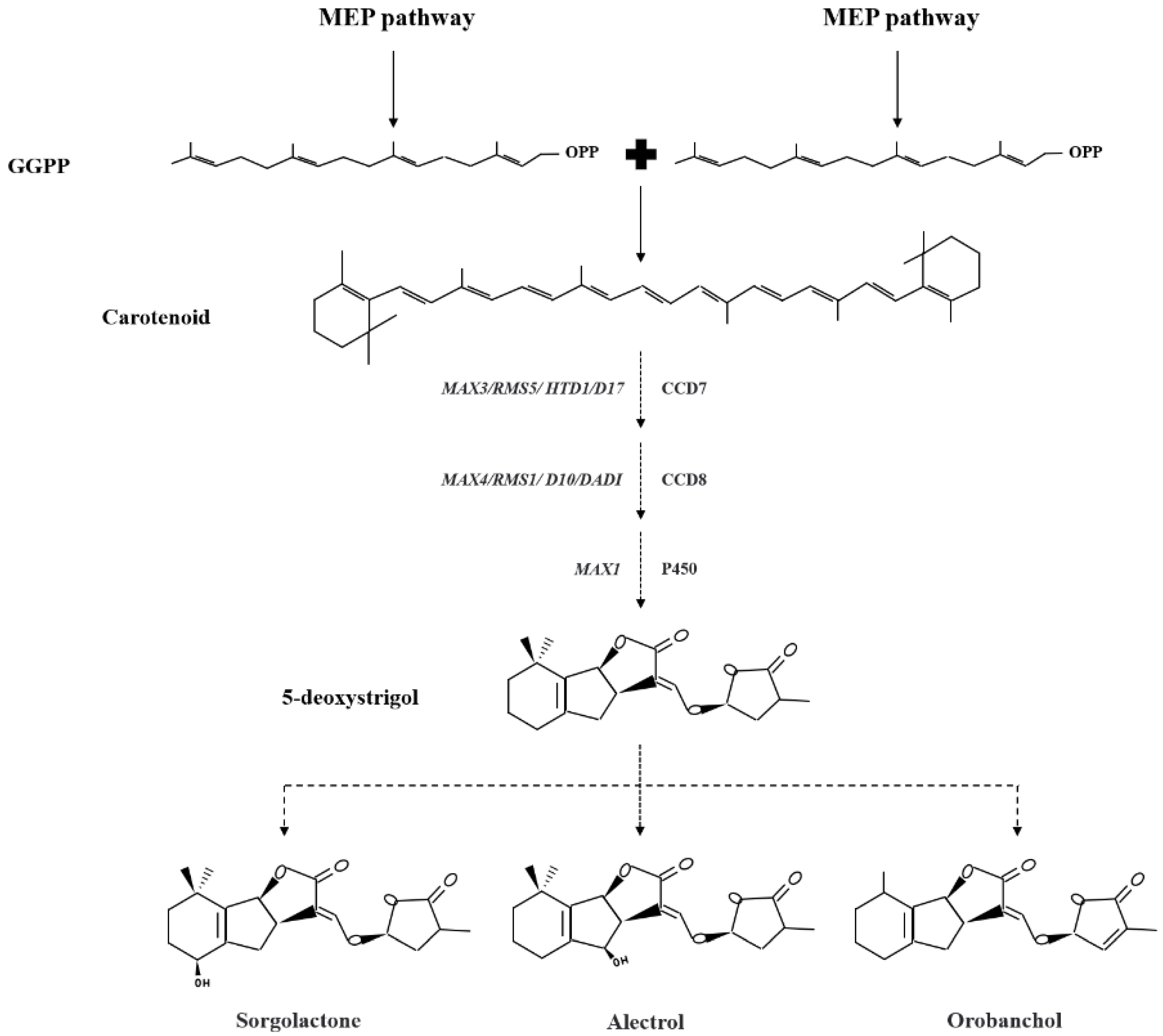
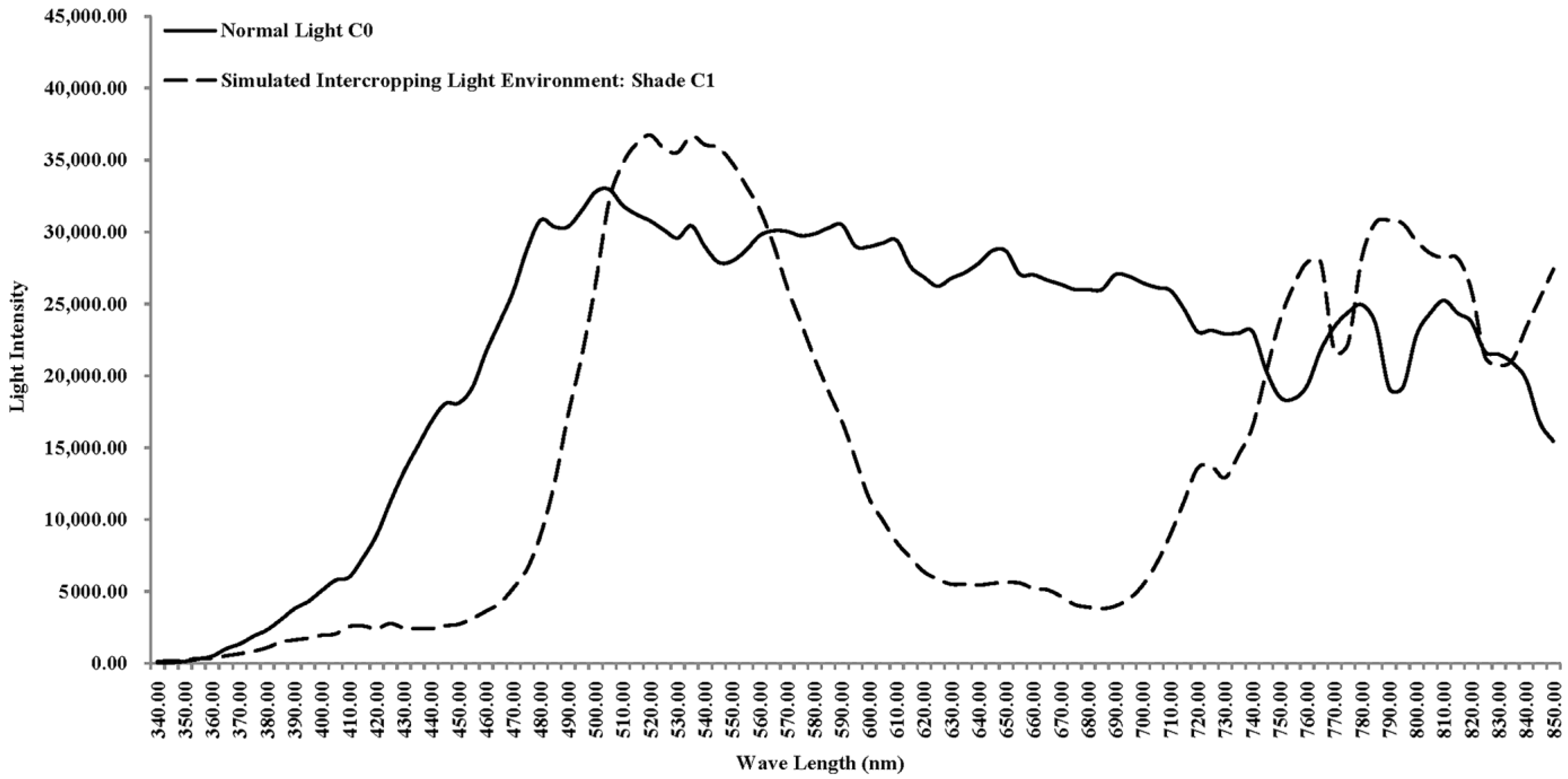
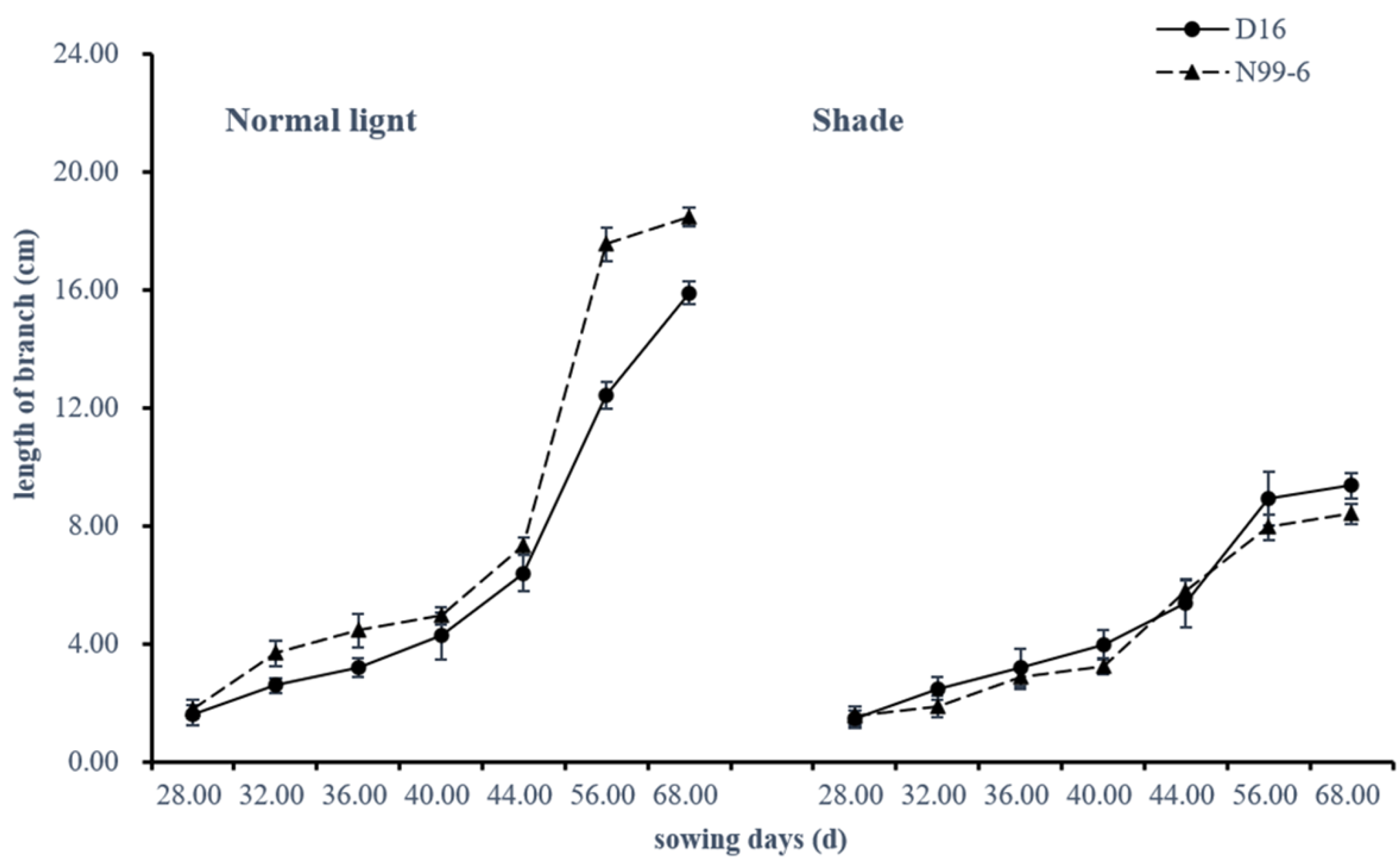
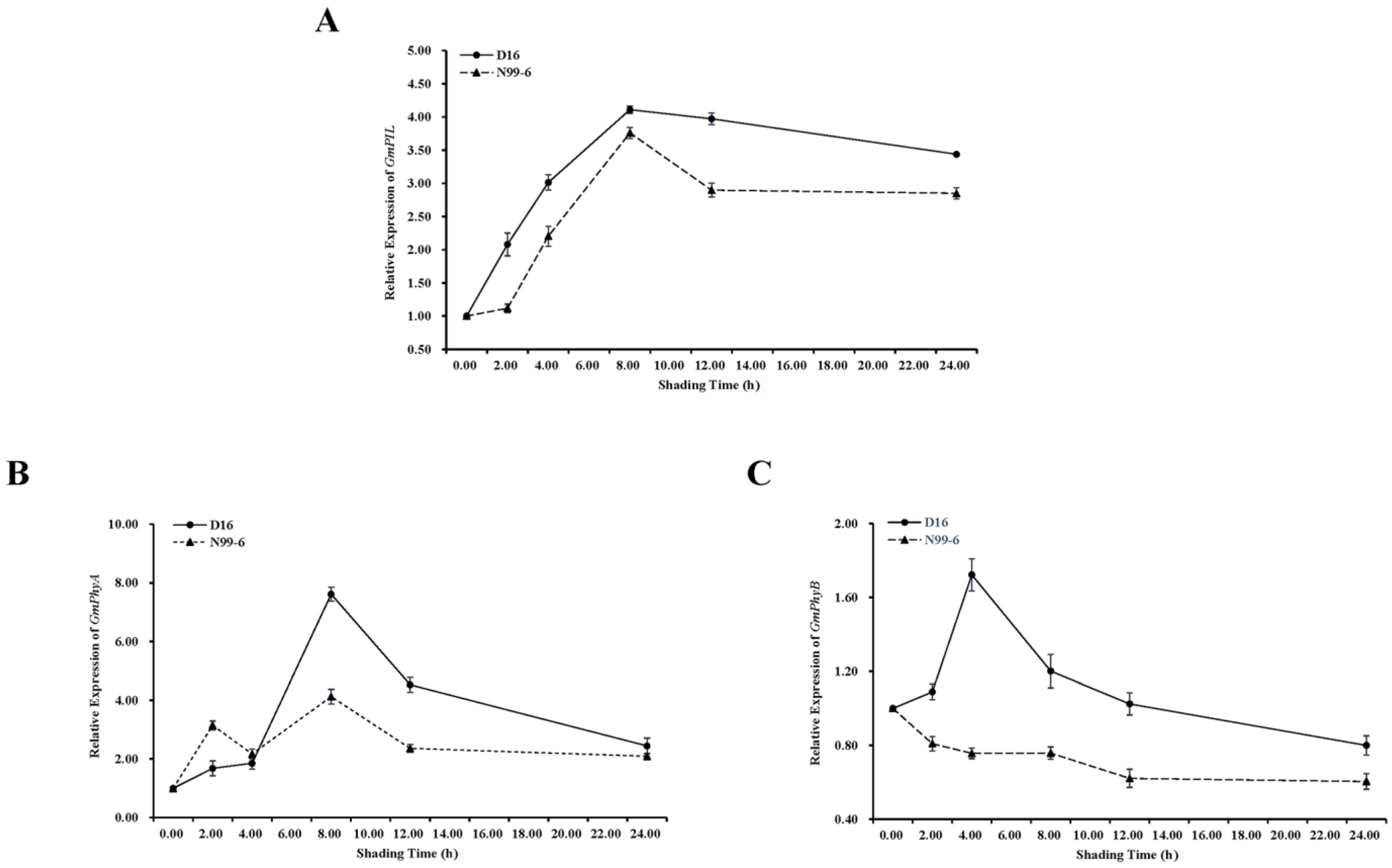



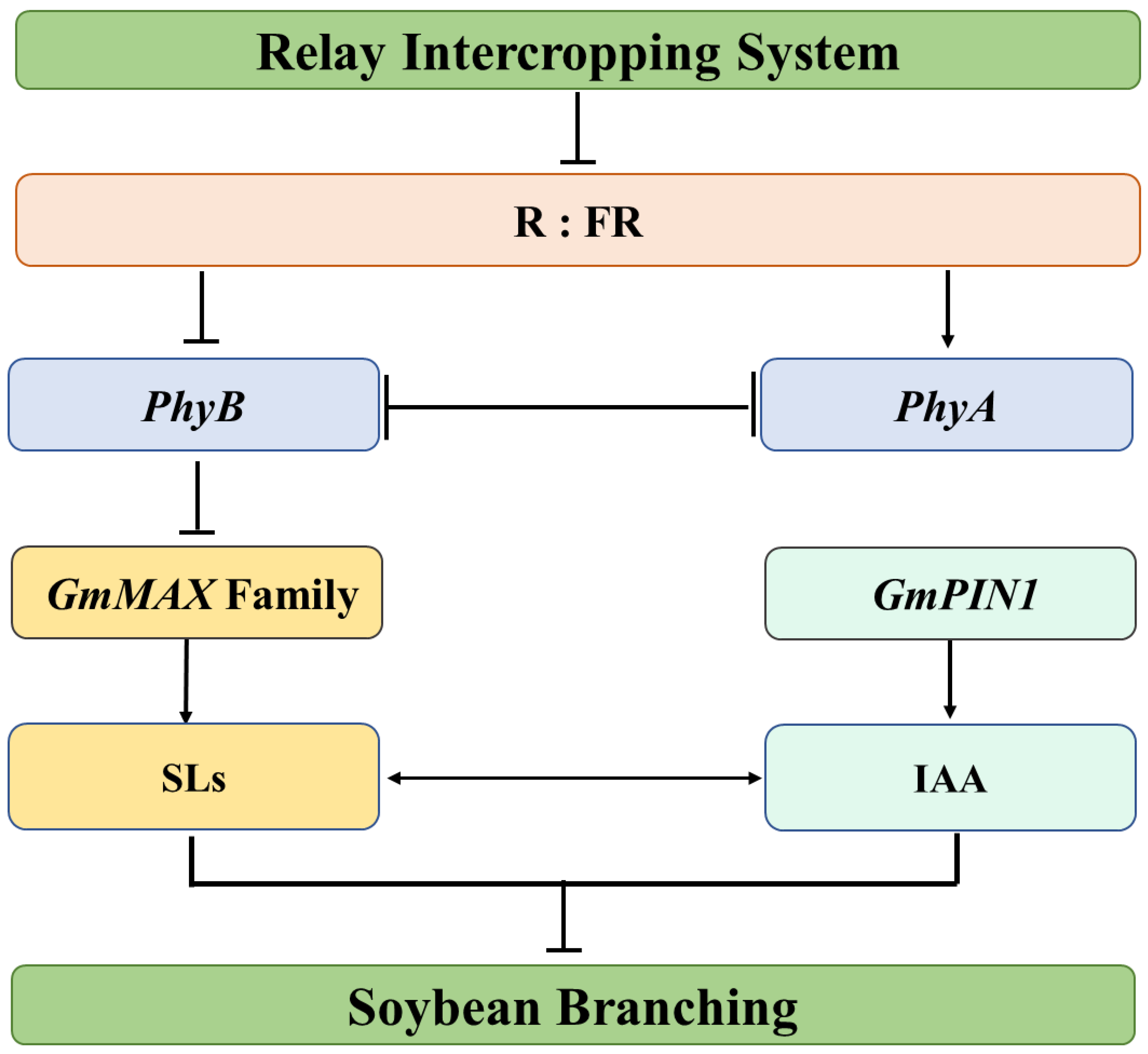
| Cultivar | Treatment | Branch Number | Branch Formation Rate | Branch Length (cm) | Branch Pod Number |
|---|---|---|---|---|---|
| D16 | normal light | 7.50 ± 0.49 | 0.58 ± 0.04 | 18.04 ± 1.902 | 17.2 ± 2.857 |
| shade | 1.40 ± 0.49 | 0.26 ± 0.04 | 17.65 ± 1.671 | 8.2 ± 1.990 | |
| N99-6 | normal light | 2.40 ± 1.02 | 0.18 ± 0.06 | 16.63 ± 1.363 | 11.7 ± 1.552 |
| shade | 1.20 ± 0.75 | 0.12 ± 0.04 | 9.82 ± 1.391 | 5.2 ± 1.249 |
| Environment | Treatment | Branch Number | Branch Formation Rate | Branch Length (cm) | Branch Pod Number |
|---|---|---|---|---|---|
| normal light | CK | 6.20 ± 0.36 | 0.583 ± 0.056 | 28.08 ± 1.35 | 18.22 ± 1.83 |
| IAA | 4.12 ± 0.65 | 0.338 ± 0.034 | 31.67 ± 2.51 | 12.83 ± 1.13 | |
| NPA | 7.23 ± 1.88 | 0.620 ± 0.076 | 26.02 ± 1.46 | 17.73 ± 1.30 | |
| GR-24 | 3.56 ± 0.72 | 0.323 ± 0.013 | 15.82 ± 1.07 | 14.92 ± 1.34 | |
| TIS108 | 10.83 ± 0.38 | 0.792 ± 0.086 | 39.23 ± 2.34 | 15.86 ± 1.36 | |
| shade | CK | 3.78 ± 0.72 | 0.352 ± 0.036 | 23.94 ± 1.31 | 7.76 ± 1.02 |
| IAA | 2.64 ± 0.12 | 0.228 ± 0.023 | 22.83 ± 1.57 | 7.18 ± 1.40 | |
| NPA | 5.80 ± 0.48 | 0.442 ± 0.084 | 24.06 ± 1.39 | 11.96 ± 1.84 | |
| GR-24 | 2.06 ± 0.49 | 0.214 ± 0.063 | 22.85 ± 1.93 | 6.63 ± 1.32 | |
| TIS108 | 7.18 ± 1.49 | 0.601 ± 0.082 | 23.68 ± 2.31 | 13.82 ± 1.79 |
| Environment | Treatment | Branch Number | Branch Formation Rate | Branch Length (cm) | Branch Pod Number |
|---|---|---|---|---|---|
| normal light | CK | 3.16 ± 0.49 | 0.314 ± 0.022 | 16.03 ± 1.88 | 10.63 ± 2.12 |
| IAA | 2.33 ± 0.20 | 0.202 ± 0.019 | 15.39 ± 1.23 | 14.68 ± 1.89 | |
| NPA | 5.62 ± 1.72 | 0.496 ± 0.036 | 15.68 ± 1.72 | 15.13 ± 1.07 | |
| GR-24 | 3.77 ± 1.49 | 0.338 ± 0.017 | 15.92 ± 1.83 | 8.23 ± 1.39 | |
| TIS108 | 7.84 ± 1.20 | 0.660 ± 0.082 | 19.36 ± 1.88 | 16.38 ± 2.12 | |
| shade | CK | 3.02 ± 0.49 | 0.297 ± 0.032 | 25.18 ± 2.22 | 5.63 ± 0.83 |
| IAA | 2.16 ± 0.65 | 0.213 ± 0.019 | 23.94 ± 2.02 | 8.66 ± 1.22 | |
| NPA | 4.33 ± 0.10 | 0.415 ± 0.032 | 24.28 ± 1.91 | 11.39 ± 1.92 | |
| GR-24 | 1.37 ± 0.57 | 0.154 ± 0.019 | 18.63 ± 1.92 | 6.39 ± 1.11 | |
| TIS108 | 6.64 ± 0.93 | 0.576 ± 0.082 | 24.88 ± 2.71 | 10.83 ± 1.79 |
Disclaimer/Publisher’s Note: The statements, opinions and data contained in all publications are solely those of the individual author(s) and contributor(s) and not of MDPI and/or the editor(s). MDPI and/or the editor(s) disclaim responsibility for any injury to people or property resulting from any ideas, methods, instructions or products referred to in the content. |
© 2023 by the authors. Licensee MDPI, Basel, Switzerland. This article is an open access article distributed under the terms and conditions of the Creative Commons Attribution (CC BY) license (https://creativecommons.org/licenses/by/4.0/).
Share and Cite
He, L.; Xu, M.; Wang, W.; Liu, C.; Yu, L.; Liu, W.; Yang, W. The Interaction between Strigolactone and Auxin Results in the Negative Effect of Shading on Soybean Branching Development. Agronomy 2023, 13, 2383. https://doi.org/10.3390/agronomy13092383
He L, Xu M, Wang W, Liu C, Yu L, Liu W, Yang W. The Interaction between Strigolactone and Auxin Results in the Negative Effect of Shading on Soybean Branching Development. Agronomy. 2023; 13(9):2383. https://doi.org/10.3390/agronomy13092383
Chicago/Turabian StyleHe, Lingxiao, Mei Xu, Wenyan Wang, Chunyan Liu, Liang Yu, Weiguo Liu, and Wenyu Yang. 2023. "The Interaction between Strigolactone and Auxin Results in the Negative Effect of Shading on Soybean Branching Development" Agronomy 13, no. 9: 2383. https://doi.org/10.3390/agronomy13092383
APA StyleHe, L., Xu, M., Wang, W., Liu, C., Yu, L., Liu, W., & Yang, W. (2023). The Interaction between Strigolactone and Auxin Results in the Negative Effect of Shading on Soybean Branching Development. Agronomy, 13(9), 2383. https://doi.org/10.3390/agronomy13092383




